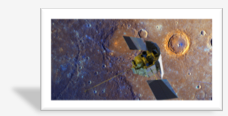 The 50th anniversary of America’s first manned spaceflight is being commemorated with the issuance of two stamps. The stamps went on sale May 4, 2011.
The 50th anniversary of America’s first manned spaceflight is being commemorated with the issuance of two stamps. The stamps went on sale May 4, 2011.
One stamp salutes NASA’s Project Mercury, America’s first manned spaceflight program, and NASA astronaut Alan Shepard’s historic flight on May 5, 1961, aboard the spacecraft Freedom 7.
The other stamp draws attention to NASA’s unmanned MESSENGER mission, a scientific investigation of the planet Mercury. On March 18, 2011, MESSENGER became the first spacecraft to enter into orbit around Mercury.
These two historic missions frame a remarkable fifty-year period in which America has advanced space exploration through more than 1,500 manned and unmanned flights.
Donato Giancola of Brooklyn, N.Y., who based the stamps on NASA photos and images, designed both stamps.
The release of the MESSENGER stamp is related to the NASA Explorer Schools content module, MESSENGER: Cooling with Sunshades. To learn more about the MESSENGER stamp, go to the article in NEON.
To use the MESSENGER: Cooling With Sunshades lesson and activity in your classroom, log into the NES Virtual Campus and click on the Teaching Materials button in the left column. The activity is an engaging, hands-on lesson covering physics concepts including temperature, latent heat, state of matter and transfer of energy.




 The 50th anniversary of America’s first manned spaceflight is being commemorated with the issuance of two stamps. The stamps went on sale May 4, 2011.
The 50th anniversary of America’s first manned spaceflight is being commemorated with the issuance of two stamps. The stamps went on sale May 4, 2011. NASA will host a news conference at 1 p.m. EDT on Thursday, June 16, to reveal new images and science findings from the first spacecraft to orbit Mercury. The event will be held in the NASA Headquarters. NASA Television and the
NASA will host a news conference at 1 p.m. EDT on Thursday, June 16, to reveal new images and science findings from the first spacecraft to orbit Mercury. The event will be held in the NASA Headquarters. NASA Television and the  This is a cool lesson related to MESSENGER’s mission to Mercury and the Inuit people inhabiting the Arctic region. By studying ancient solutions to the issue of excessive sunlight on human vision, students better understand the process of designing solutions to similar problems for MESSENGER.
This is a cool lesson related to MESSENGER’s mission to Mercury and the Inuit people inhabiting the Arctic region. By studying ancient solutions to the issue of excessive sunlight on human vision, students better understand the process of designing solutions to similar problems for MESSENGER.